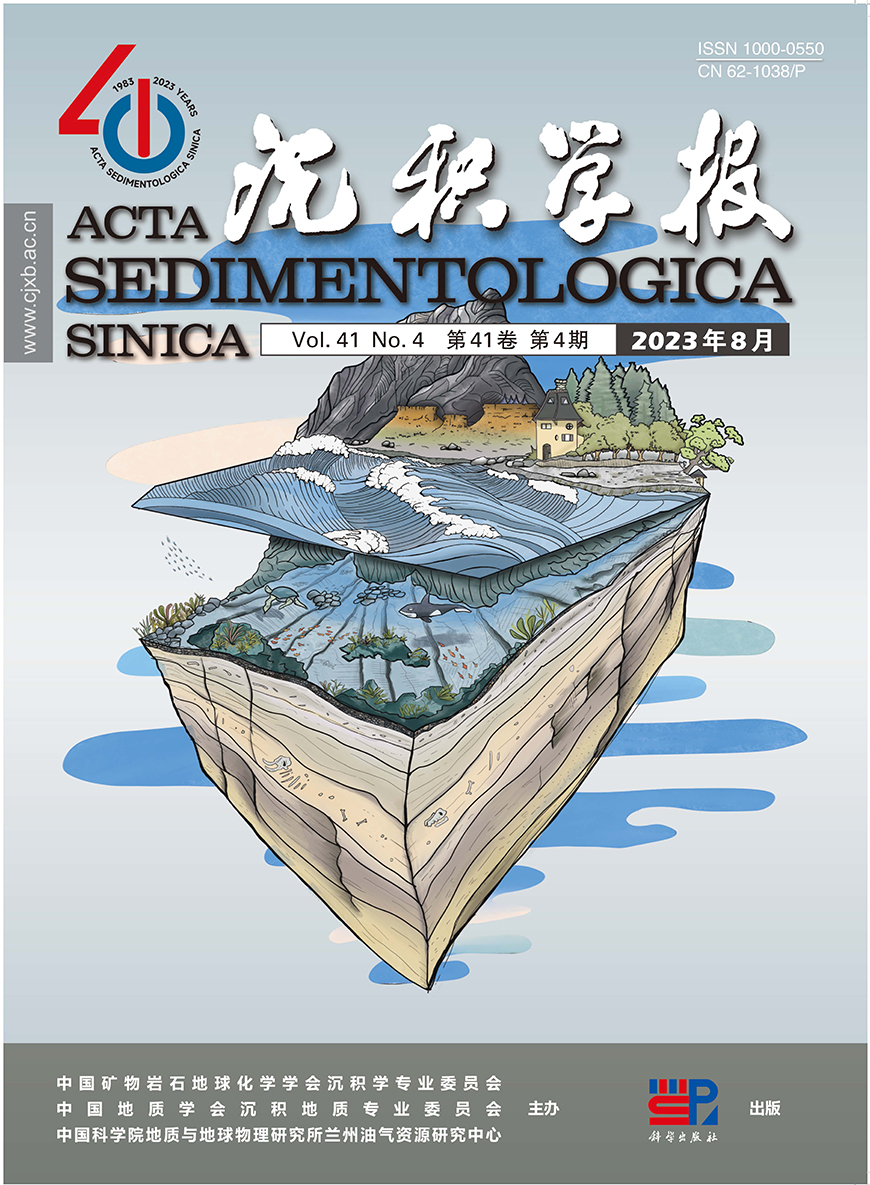HTML
-
鄂尔多斯盆地是我国大型含油气盆地之一,蕴藏丰富的油气资源。其西缘位于华北陆块和秦祁昆造山带两个性质迥然不同的一级大地构造单元之间近南北向的狭长地带[1],是我国北方东西部不同构造单元的连接地区[2⁃4]。近年来,专家学者开始关注鄂尔多斯盆地西缘及其邻区的油气勘探潜力[5⁃8],多期次的构造活动直接影响研究区的古地理格局、物源方向、砂体沉积厚度和岩性等[9],砂体时空展布和成因机制的差异决定了鄂尔多斯盆地西缘羊虎沟组生储盖层的有利组合[10]。
鄂尔多斯盆地西缘从晚石炭世早期前黑山组开始接受沉积,晚石炭世末期羊虎沟组大致与华北克拉通的本溪组相当[11⁃12]。羊虎沟组在盆地西缘分布面积较广,厚度变化较大,是良好的烃源岩地层[3]。受沉积模式认识差异影响,不同学者对砂体成因持有不同观点,大部分学者认为鄂尔多斯盆地西缘羊虎沟组时期主要发育潮控三角洲和障壁岛海岸沉积体系,有学者认为还发育了浅海陆棚和扇三角洲沉积体系[13⁃17]。受构造运动影响,该地区沉积环境变化频繁,砂体沉积类型多样。目前对羊虎沟组砂体形成和沉积过程的认识较为薄弱,单一的沉积模式无法很好地解释研究区砂体复杂的成因机制和较强的非均质性。综上所述,本文基于研究区乌达、呼鲁斯太等10余处野外露头剖面的勘察研究,以及对巴参2井、阿参1井等40余口井位的岩心观察及钻井等资料,通过系统研究鄂尔多斯盆地西缘及其邻区羊虎沟组砂体的沉积特征,阐明其成因机制,揭示其展布规律与沉积过程,并进一步明确其主要控制因素,以丰富鄂尔多斯盆地油气勘探理论,促进裂陷盆地砂体成因机制和沉积过程的研究。
-
鄂尔多斯盆地西缘位于华北克拉通西部,地跨陕、甘、宁、蒙,研究区北起内蒙古乌海市,南经宁夏银川、同心、海原至环县一带,东始陕西定边、内蒙古鄂托克前旗。主体呈南北向展布,在区域大地构造位置上,鄂尔多斯盆地西缘构造带位于鄂尔多斯地块、阿拉善地块和北祁连构造带三大构造单元交汇地区,是连接中国东西部不同大地构造单元的枢纽地带(图1a)[2,8,18]。研究区内见鄂尔多斯盆地六大构造单元中的伊盟隆起、西缘逆冲带、天环凹陷和伊陕斜坡四个构造单元,以及阿拉善地块东部的巴彦浩特盆地(图1b)。这种特殊的构造位置使其在不同地质历史时期经历了多期次拉张裂陷、挤压闭合活动[2⁃4,7,19]。
石炭纪—二叠纪冈瓦那大陆不断向北运动,特提斯洋被阻,古亚洲洋封闭,泛大陆逐渐形成[20]。在奥陶纪末期,加里东运动使华北克拉通大面积抬升,造成大面积海退[1,21]。早石炭世,盆地西缘贺兰坳拉槽发生横向拉张复活,形成狭窄的裂陷盆地,祁连海沿该裂陷带侵入盆地[22⁃24]。晚石炭世,鄂尔多斯地区经过长期剥蚀后,又有海水侵入,缓慢沉降并接受沉积[21,25],区内海水时进时退,以温暖湿润气候为主,为低能的闭塞海湾或湖沼潮湿环境[14]。晚石炭世盆地中央古隆起横跨盆地南北,分割祁连海与华北海[1],位于古隆起西部的祁连—贺兰海域形成了海陆交互相含煤沉积的羊虎沟组[26⁃27],到早二叠世早期古隆起进一步沉降,形成统一陆表海[1]。研究区北部沉积物来源于盆地西北部的阿拉善古陆和东北部的阴山古陆,南部沉积物来源于北祁连和北秦岭造山带[4,28⁃34]。
-
鄂尔多斯盆地西缘祁连海域石炭纪—二叠纪沉积地层自下而上划分为石炭系前黑山组、臭牛沟组、靖远组、羊虎沟组,其上为二叠系太原组、山西组、石盒子组和石千峰组。石炭系前黑山组、臭牛沟组地层以粗碎屑岩及大套厚层生物灰岩为特征,靖远组以黑色泥页岩广泛发育为特征。太原组主要为灰白色细砂岩、灰—灰黑色泥岩、碳质泥岩、煤层。下二叠统太原组、山西组发育海陆交互相碎屑岩沉积,上二叠统石盒子组、石千峰组发育河流相碎屑岩沉(图2a)[4,35]。
鄂尔多斯盆地西缘羊虎沟组为上古生界石炭系地层,可划分为羊三段、羊二段和羊一段。羊虎沟组岩性主要为灰白色(含砾)石英砂岩,与灰黑色粉砂岩和黑色泥岩呈韵律性互层,夹少量灰岩和薄煤层[8,11,18]。羊三段以中细砂岩为主,夹薄层煤、灰黑色泥岩和灰色泥质粉砂岩,地层厚度为300~450 m;羊二段为灰黑色泥岩与灰色细—粗砂岩呈不等厚互层,夹薄层煤、灰色泥质粉砂岩和深灰色粉砂质泥岩,见植物化石,地层厚度为400~500 m;羊一段以灰黑色泥岩为主,与灰色中—细砂岩、灰色泥质粉砂岩和深灰色粉砂质泥岩组成韵律层,夹薄层煤,见植物和介壳化石,地层厚度为100~150 m。羊虎沟组与上覆太原组和下伏靖远组均呈整合接触,与奥陶系或更老地层呈不整合接触(图2b)[3,8,26,36]。
羊虎沟组分布于甘肃靖远、景泰、武威一带,是加里东运动后石炭纪祁连海逐渐向东推进到鄂尔多斯盆地西缘的沉积产物[8],在祁连海域海侵时范围扩大到最大,并越过中央古隆起与华北海域连通。研究区东部鄂托克旗—定边一带因发育在中央古隆起之上,因此沉积厚度较薄,环县以西越过中央古隆起,沉积厚度迅速加大,总体呈西厚东薄的特征[1,4,8]。
-
岩相是一定沉积环境中形成的岩石或岩石组合,不同岩相类型组合反映不同微相的沉积过程[37⁃38],是划分沉积微相、识别砂体成因的重要依据[39]。鄂尔多斯盆地西缘羊虎沟组中共识别出6种岩相组合。
-
A1(Gt-Sp-Sh):大型槽状、板状交错层理和平行层理灰白色含砾砂岩—砂岩—粉砂岩。砾石粒径2~5 mm,分选中等,磨圆度次圆—圆状,具向上变细的正粒序特征,粒度分布概率曲线以“滚动、跳跃加悬浮”的三段式为主。砂体呈透镜状,侧向迁移叠置,长3~8 m,厚0.2~1 m。见底冲刷,对下伏地层侵蚀强烈,最大侵蚀深度约30 cm,规模较大,长7~8 m。冲刷面之上砂体底部可见次圆—圆状砾石,分选中等—差,粒径5~20 mm,具定向性,冲刷面之下见碳质泥岩及煤层,煤层平均厚度20 cm,层面平直,连续性好,夹于粉砂质、碳质泥岩之间延伸5~6 m。
A2(Sw-Sh):楔状交错层理和水平层理浅灰色中细砂岩—粉砂岩。结构及成分成熟度较高,为向上变粗的逆粒序特征,粒度分布概率曲线以“一跳一悬加过渡”的三段式为主。
-
B1(Gm-St-Sf-M):小型槽状、羽状交错层理灰白色含砾中粗砂岩—细砂岩。砾石粒径2~5 mm,整体粒度较粗,颗粒支撑,发育与A1类似的粒序及粒度特征,粒度分布概率曲线以跳跃搬运为主。砂体顶平底凹,发育小规模底冲刷,冲刷面底部可见次棱角状砾石,分选差,粒径2~50 mm,砂岩内见介壳化石。冲刷面之下碳质泥岩内夹煤线,层面呈波状,连续性差。
B2(Sf-Sp-Fc):羽状、板状交错层理和脉状层理浅灰色粉—细砂岩,夹灰黑色泥质条带。整体砂质含量高,具向上变细的正粒序特征,泥岩中见虫孔。
B3(Sf-Sp-Sw):羽状、楔状和板状交错层理浅灰色中粗砂岩。结构及成分成熟度高,具向上变细的正粒序特征,粒度分布概率曲线以滚动搬运为主。见前积层理,沿水平方向层厚较稳定,单层系厚度20~30 cm,层系向前推覆叠置,相邻层系砂体间发育泥质披盖层。
-
C1(Gt-Sp-Sh):中、小型槽状、板状交错层理和平行层理浅灰色含砾粗砂岩。砾石以石英为主并具有定向性,砾石粒径2~10 mm,颗粒支撑,基质含量小于15%,结构及成分成熟度较低,具向上变粗的逆粒序特征,粒度分布概率曲线以滚动搬运和跳跃搬运为主。
C2(Sh-M):平行层理灰黑色细砂岩—泥质粉砂岩—泥岩。浅灰色粉砂岩中见撕裂状泥砾,形状不规则,见植物碎片。
-
D1(Fr-Sh):灰白色中粗石英砂岩—中细砂岩,水平层理和小型砂纹交错层理灰白色粉砂岩。结构及成分成熟度较高,具向上变粗的逆粒序特征,粒度概率曲线以跳跃搬运为主。砂体底平顶凸,砂岩层面见波痕。
D2(Sf-Sp-Fc-Fr):大—中型羽状、板状交错层理及脉状层理灰黑色中细砂岩—粉砂岩,灰黑色薄层泥与粉砂岩互层。砂泥接触面弯曲呈波状,具向上变细的正粒序特征,粒度概率曲线以跳跃总体和悬移总体为主。见灰白色前积砂质层夹灰黑色黏土质泥层的双黏土层,见植物碎片。
D3(M-Lm-C):水平层理黑—灰黑色泥岩,夹薄层粉砂岩。泥岩中见黄铁矿,植物叶片化石保存较为完整,泥岩和粉砂岩中见大量煤层,部分煤层厚度可达1 m。
-
冲洗交错层理和低角度交错层理砾岩—含砾砂岩—粉砂岩。砾石主要为石英,砾石粒径2~3 mm,颗粒分选好,磨圆度次圆—圆状,具有极高的成分和结构成熟度。单层厚度大,为2~4 m,具向上变粗的逆粒序特征。
-
以含泥砾浅灰色粉细砂岩—黑色泥岩为主。整体具向上变细的正粒序特征。砂砾岩内夹泥质撕裂屑及泥砾,具定向性,砾石磨圆度较中等—好,但分选差(5~20 mm)。砂体滑塌卷入泥岩中,横向规模超过3 m,发育同沉积小断层及大量变形构造,揉皱变形沉积构造的轴向方向大体一致。
-
鄂尔多斯盆地西缘羊虎沟组相带发育复杂,根据不同类型的岩相组合、沉积构造及粒度分析等特征,认为6种岩相组合对应以下6类成因机制。
-
河控三角洲沉积特征主要表现为河道牵引流成因的单向层理特征[15],主要对应于岩相组合A。砂体粒度较粗且为正粒序,砂砾岩底部见大规模底冲刷(图3d),反映强烈的侵蚀—充填过程,底部砾石分选磨圆较好,叠瓦状排列具定向性,指示单向水流方向。透镜状砂体侧向迁移叠置(图3b),见槽状、板状交错层理及平行层理等单向水流构造(图3a,c),对应河控三角洲水下分流河道侧向摆动沉积砂体特征。砂质较纯且为逆粒序,苏峪口粒度概率曲线表现为三段式(图3f),主要反映中等强度震荡水流沉积环境;可见楔状交错层理,对应河控三角洲远砂坝—河口坝砂体特征。
-
由于受潮汐作用强烈影响,潮控三角洲砂体总体呈现出受韵律性双向水流影响的沉积构造,主要对应于岩相组合B。垂向层序下部主要为具有双向交错层理和生物碎屑的潮汐砂脊沉积,向上变为粒度较细的潮坪沉积,夹有交错层理的潮道砂体沉积[40]。顶平底凹状砂体夹于砂泥互层的潮汐层理中(图4f)[41],发育典型的羽状、小型槽状交错层理(图4c,d)。小型冲刷面凹凸不平,砾石分选磨圆中等,表明较强烈冲刷作用,反映潮汐作用环境,对应潮道砂体沉积特征[15]。砂质含量高,夹少量泥岩层,发育的脉状层理反映供砂充分且水动力较弱的潮汐环境(图4g),对应砂坪沉积特征。不连续的透镜状砂体延伸较长且为前积状,具正粒序结构,层间夹泥质披盖层(图4b),反映砂质供给充足且水动力较强的潮汐作用环境,对应潮控三角洲前方远端潮汐砂脊特征。
-
扇三角洲是由冲积扇作为物源,在活动的扇体与稳定水体交界地带沉积的沿岸近源扇状沉积体系[42],主要对应于岩相组合C。阿参1井下部粗碎屑沉积段为颗粒支撑,砾岩和含砾粗砂岩成分及结构成熟度低(图5a),沉积物以滚动、跳跃方式搬运[43],说明扇体紧邻物源区,为短距离搬运快速沉积的近源沉积体系,对应扇三角洲前缘近端叠置的主河道砂体沉积特征[44]。中部过渡到粉砂质砂体,粒度明显变细,对应扇三角洲前缘远端水下分流河道砂体,水动力逐渐减弱。泥岩中见形状不规则的粗粒砂体,砂岩中也可见垮塌泥砾(图5b~d),为深水陡坡沉积环境下砂体滑塌入海,推测为扇三角洲水下局部重力流沉积,对应前扇三角洲沉积特征。
-
障壁岛海岸沉积体系为海陆过渡相,由于障壁岛隔开沿岸海域与外围广海,广海一侧发育开阔陆表海,向岸一侧受潮汐作用发育潮坪—潟湖沉积体系[45],主要对应于岩相组合D。砂体粒度较细且为逆粒序,底平顶凸状砂体可见波痕(图6e),反映水动力较强的潮汐和波浪联合作用环境,对应障壁岛砂体沉积特征。砂泥互层形成的波状层理、脉状层理(图6a,g)和小型羽状交错层理(图6f),反映韵律性潮汐作用。砂体粒度向上从中细砂岩到粉砂岩逐渐变细,反映潮下带至潮间带水动力逐渐减弱。双黏土层(图6b)是在潮汐作用下形成的一种标志性沉积构造,前积砂质层和黏土质泥层厚度不均,表明涨潮退潮能量不均[46],对应潮坪沉积特征。含碳泥岩层面见黄铁矿及完整的植物叶片(图6c,d),反映还原闭塞的静水沉积环境,对应潟湖沉积特征。
-
无障壁海岸位于与大洋连通性好的海岸地带,与广海陆棚之间没有被障壁岛、滩,或生物礁隔开,海岸受较明显的波浪及沿岸流的作用,海水可以充分流通和循环[47],主要对应于岩相组合E。砂体粒度粗,砾岩、砂砾岩与含砾粗砂岩中石英含量极高(图7a,b),发育低角度及冲洗交错层理(图7c),反映水动力较强的海浪冲刷及波浪淘洗沉积环境,对应滨岸砂体沉积特征[48]。泥质含量增高,说明受波浪作用影响小,对应浅水—半深水陆棚沉积特征[49]。
-
滑塌重力流沉积具有砂泥变形构造,同沉积微断层,泥质撕裂屑、不规则接触面等典型的塑性变形构造[50⁃52],主要对应于岩相组合F。砂岩与泥岩呈突变接触,接触面不规则,可见大量层间揉皱变形(图8a),阶梯状小断层错断内部弱固结的砂泥纹层(图8b),反映其处于快速沉积的半固结状态。磨圆较好的砂砾、泥砾(图8c)和棱角尖锐呈撕裂状的泥质撕裂屑(图8d)分散在粉砂岩中,具定向性,推测为沉积物重力失稳后发生快速滑塌,砂砾表面圆滑,在滑塌后可能发生了流动搬运[53]。砂体整体呈块状发生滑动滑塌进入泥岩中(图8e),反映稳定深水且沉积坡度较大的沉积环境,对应滑塌重力流沉积特征[54]。
3.1. 岩相组合特征
3.1.1. 岩相组合A(Gt-Sp-Sw-Sh)
3.1.2. 岩相组合B(Gm⁃St⁃Sf⁃Sp⁃Fc⁃Sw⁃M)
3.1.3. 岩相组合C(Gt-Sp-Sh⁃M)
3.1.4. 岩相组合D(Fr⁃Sh⁃Sf⁃Sp⁃Fc⁃M⁃Lm⁃C)
3.1.5. 岩相组合E(Gt⁃Gp⁃Sp⁃Sl)
3.1.6. 岩相组合F(Gm⁃Fc⁃M)
3.2. 砂体成因机制分析
3.2.1. 河控三角洲成因砂体
3.2.2. 潮控三角洲成因砂体
3.2.3. 扇三角洲成因砂体
3.2.4. 障壁岛海岸成因砂体
3.2.5. 无障壁海岸砂体
3.2.6. 重力流砂体
-
根据对研究区野外露头剖面、岩心观察和钻井资料分析,选取平面上分布均匀、层位较全的巴参2井、苏峪口、呼鲁斯太等11处钻井及剖面(连井平面位置见图1b),进行综合地层划分对比。
由北侧东西向沉积相对比剖面图(图9)可以看出,羊虎沟期地层厚度有明显差异,整体呈“东厚西薄”的特点,在呼鲁斯太处达到最深,厚约700 m,鄂16井沉积厚度较薄,不足40 m,东部砂体发育程度优于西部砂体。羊三段至羊二段砂体横向上连续性差,但砂体沉积厚度较大,发育潮控三角洲沉积体系的潮汐砂脊砂体。羊一段地层厚度及砂体厚度较小,在东西向上连通性较好,沉积环境与物源供给较稳定,具有填平补齐特征,发育河控三角洲沉积砂体。该剖面表明羊虎沟组整体在纵向上具有水体由深变浅的特征。

Figure 9. East⁃west sedimentary contrast profile of the Yanghugou Formation in the western margin of the Ordos Basin (north side A-A')
南侧东西向沉积相对比剖面图(图10)表明羊虎沟组受中央古隆起影响,仍呈“东厚西薄”的特点,地层厚度较北部有所增加,在韦参1井处达到最深,厚约650 m,李64井处沉积厚度较薄,厚约30 m。该对比剖面揭示砂体横向上连续性差,韦参1井处羊二段单个砂体沉积厚度较大。羊三段至羊二段东侧发育障壁砂坝和少量重力流砂体,西侧地势较陡,发育大量重力流成因砂体。羊一段东侧发育河控三角洲沉积砂体,西侧发育障壁海岸沉积体系中的障壁岛砂体。该剖面在纵向上仍具有水体由深变浅的特征。
-
羊三段沉积时期,整体地层沉积特征呈由北向南的“喇叭口”形,研究区主要发育南北两个沉降中心,北部位于呼鲁斯太—乌达一带,为一个狭窄的沉积区,最大厚度约为200 m,砂体集中分布于此。南部沉降中心位于大石头井沟—中卫地区,最大厚度约为400 m,砂体主要位于该沉降中心南侧高部位。
研究区东北部发育潮控三角洲沉降体系,受潮汐作用影响,砂体主要为潮道、潮坪和潮汐砂脊,最大砂厚约90 m。垂向上潮坪砂质含量高,夹于潮道间,平面上潮汐沙脊砂体形态为典型裂指状,从河口处向海洋方向放射状分布,中部地区零星可见平行中央古隆起的潮汐砂脊砂体,呈北东—南西向展布。西北部阿参1井地区发育扇三角洲,整体粒度较粗,河流作用为主使其平面形态呈扇形,砂厚约60 m,垂向上具向上粒度变粗的逆粒序结构特征。南部砂体整体表现为无障壁海岸沉积,展布方向与海岸线大致平行,下河沿地区局部可见重力流沉积砂体(图11)。
-
羊二段沉积时期,地层沉积范围扩大,北部沉降中心向南迁移至石嘴山东部,最大厚度约为300 m;南部沉降中心依然位于大石头井沟—中卫地区,厚度增加到500 m。相对于羊三段沉积期,该时期地层厚度增加,沉降面积扩大,南北砂体展布面积增大,并逐渐向东超覆。
研究区北部受潮汐作用影响的范围增大,潮汐沙脊沉积砂体最远可延伸至银川以南地区。潮汐砂脊平面上为北东—南西方向展布,单个砂体平行于中央古隆起边界,厚度变化大,整体厚度10~90 m不等。土坡—大石头井沟一带发育重力流沉积,校育川地区也局部可见,发育丰富的同沉积构造变形沉积特征。南部开始发育河控三角洲,中卫、小洪沟局部地区可见透镜状障壁沙坝。中央古隆起西侧潮汐砂脊被逐渐改造为小型障壁岛,东部高部位逐渐开始发育潮坪—潟湖沉积砂体(图12)。
-
羊一段沉积时期,地层沉积范围进一步扩大,北部沉降中心逐渐填平补齐,南部沉降中心继续向北迁移至吴忠地区,最大厚度约为200 m。相较羊三、羊二段沉积期,地层沉积厚度减小,但沉积范围大面积扩大,研究区沉积砂体逐渐东西连片。
研究区北部三角洲转变为河控三角洲沉积体系,砂体形态为向海突出的朵体,砂厚小于50 m,推进至银川附近。南部河控三角洲砂体向北推进至下河沿地区。研究区中央古隆起西侧的潮汐砂脊被逐渐改造为障壁岛砂体,砂厚10~30 m。被改造形成的障壁岛砂体平面上呈北东—南西方向展布,障壁岛以东则整体为潮坪—潟湖沉积。中央古隆起此时变为水下低凸起,对砂体的阻隔作用变弱致使西缘沉积体系与东部相连(图13)。
4.1. 沉积相演化
4.2. 沉积砂体展布
4.2.1. 羊三段沉积期
4.2.2. 羊二段沉积期
4.2.3. 羊一段沉积期
-
鄂尔多斯盆地西缘地区为克拉通边缘裂陷盆地,该类盆地的砂体沉积通常受控于构造、古地貌、物源及海平面等因素[55]。西缘及邻区为裂陷海湾背景,具有弱物源、强构造的特征,构造活动控制着研究区物源供给差异与沉积充填演化过程[56⁃57]。鄂尔多斯盆地西缘及邻区在漫长的构造演化过程中形成中央古隆起与裂陷等构造单元[20⁃21],决定了研究区古地貌格局,而构造运动影响下的古地貌往往控制着物源通道的分布和砂体的汇聚方向[58]。不同物源区的构造背景差异决定了其供源能力的强弱,从而制约着盆内的砂体展布与源—汇系统分异特征[59]。此外,构造演化驱动下的海平面升降影响可容纳空间的改变,控制了不同时期砂体的发育特征[57]。
-
研究区羊虎沟组时期,沉积盆地整体呈“喇叭口”形,受裂陷海湾水进水退影响和东部中央古隆起的障蔽作用,沉积相带大致呈北东—南西方向展布。北部紧邻阿拉善—阴山古陆,由于构造活动强烈,地势较陡;南部与秦岭—祁连造山带相连,构造相对较弱,地势低缓。
研究区内羊三段沉积时期为裂陷初期,盆地整体狭窄。东北部水下低凸起两侧低地貌成为砂体运移的通道,控制砂体沉积过程,中央古隆起分割祁连海和华北海,阻挡了砂体向东的运移。由于北部构造活动强烈,且临近物源区,河流携带粗粒沉积物在陡坡部位快速堆积形成扇三角洲。南部构造活动较弱,无明显输砂体系,则表现为无障壁海岸沉积。
羊二段沉积时期为裂陷高潮期,海侵范围扩大,潮汐作用增强,潮控三角洲沉积砂体受潮汐作用改造强烈。构造活动导致盆内地势高差大[60],土坡—大石头井沟区域深水斜坡环境下发育滑塌重力流沉积。鄂托克旗—定边地区砂体发育在中央古隆起之上相对高部位,可容纳空间较小,发育潮坪沉积砂体。
羊一段沉积时期,构造活动减弱,沉积环境稳定且水体变浅,河流搬运占主导作用。羊三、羊二沉积期形成的潮控三角洲逐渐转变为大面积连片发育的河控三角洲沉积。三角洲前缘水下分流河道和河口坝成因砂体,由于地貌减缓、可容纳空间的降低,向前进积至盆地沉积中心附近。中央古隆起主体位于水下,对砂体的控制作用逐渐减弱,发育东西连片的障壁岛和潮坪—潟湖沉积。
-
物源方向决定了盆地内部三角洲相砂体的发育位置与推进方向[57],对整个盆地的沉积作用和构造演化等方面意义重大[5]。研究区北部砂体主要来自北部的阴山古陆、西北缘的阿拉善古陆,南部砂体则主要来自秦岭—祁连造山带[27],其中北部物源是控制区内羊虎沟组砂体沉积的最主要物源[61]。
羊虎沟组沉积时期,鄂尔多斯盆地西缘整体为北东—南西方向供源,北部物源供给相对较强[29]。晚古生代早—中期,华北板块大面积隆升,古阴山褶皱造山带形成,产生物源供给区[28,61]。早石炭世,阿拉善地块开始遭受海侵,阿拉善古陆隆升后物源供给比较稳定[62],与阴山古陆物源在呼鲁斯太地区汇合并共同向南继续推进。羊虎沟组沉积时期北秦岭构造带与华北板块南缘发生碰撞,是南部物源体系的重要组成部分[29],研究区西南部开始发育小型河控三角洲砂体。随着物源供给进一步增强,研究区北部和南部河控三角洲砂体大面积发育。
-
研究区在羊虎沟组沉积期总体气候温暖潮湿[14],一年四季降雨充沛,为海陆交互相沉积建造[17],水系分布广泛,形成大量中—小型三角洲沉积体系和障壁海岸沉积体系。研究区羊虎沟组沉积期的海平面变化为一套完整的海进海退旋回,羊一段沉积时期为大面积的海退期[63]。羊三段沉积时期海平面总体上升,可容纳空间较高[64],较低的输砂速率,致使盆地三角洲朵体较小,且容易受到潮汐作用的改造。至羊二段沉积时期,海平面达到最高,可容空间快速增大,物源供给虽然增强,但总体仍表现为欠补偿背景下的边缘沉积。潮控三角洲砂体大部分位于潮间—潮下带,该时期潮汐砂脊最为发育。到羊一段沉积时期,海平面快速下降,可容空间迅速减小,砂体不断向盆内沉积中心推进[64]。多期次三角洲前缘河道侧向迁移分布使三角洲面积逐渐扩大。
5.1. 构造—古地貌
5.2. 物源
5.3. 气候与海平面
-
(1) 鄂尔多斯盆地西缘及邻区羊虎沟组中可识别出6种岩相组合,对应河控三角洲、潮控三角洲、扇三角洲、障壁岛海岸、无障壁海岸和滑塌重力流6类成因机制。
(2) 羊三段沉积时期,北部发育潮控三角洲和扇三角洲砂体,潮汐砂脊从入海口向广海呈放射状分布,中部少量潮汐砂脊平行于中央古隆起,南部砂体表现为无障壁海岸沉积;羊二段沉积时期,北部潮控三角洲砂体被强烈改造,盆地中央斜坡部位发育重力流沉积,中央古隆起西侧潮汐砂脊被逐渐改造为小型障壁岛,其高部位逐渐发育潮坪—潟湖沉积,南部开始发育河控三角洲砂体;羊一段沉积时期,河流搬运占主导,研究区北部和南部潮控三角洲完全演变为河控三角洲。中央古隆起演化为水下低凸起,障壁岛有效隔绝广海与中央古隆起东侧水体,古隆起之上潮坪—潟湖沉积大面积发育且连片分布。
(3) 羊三段沉积时期为裂陷早期,狭窄的裂陷盆地制约砂体发育,该时期砂体展布主要受构造活动和潮汐作用控制;羊二段沉积时期为裂陷高潮期,海侵范围扩大,构造活动和海平面变化控制该时期的砂体沉积过程;羊一段沉积时期,构造活动减弱,中央古隆起主体位于水下,砂体东西连通。鄂尔多斯盆地西缘及邻区羊虎沟组砂体沉积过程受构造运动、古地貌演化、物源供给、古气候、海平面等多因素共同影响,但主要受控于构造活动与古地理演化。



















 DownLoad:
DownLoad:











